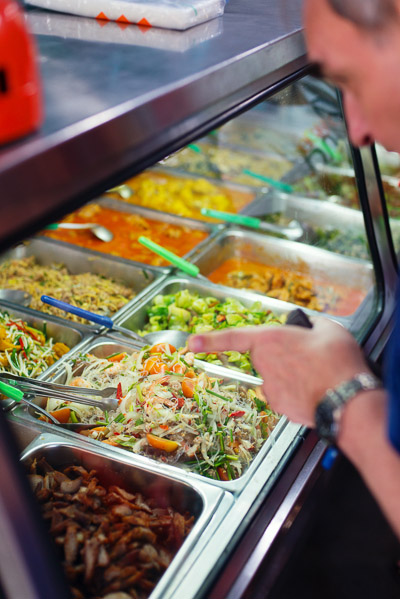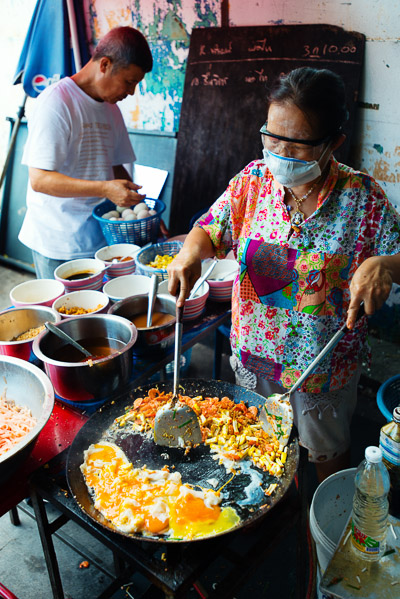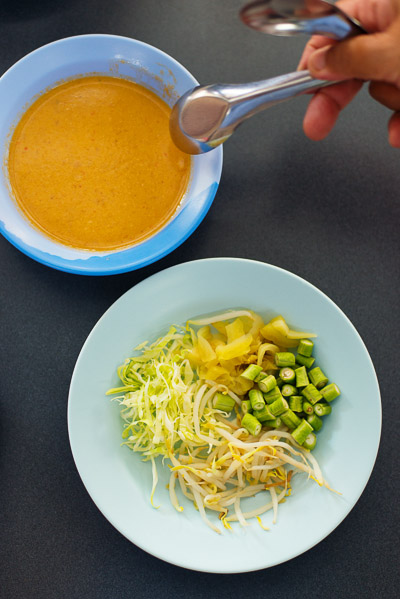 In Bangkok, if the restaurant you're eating at has completely neglected the concept of interior design, and/or its clientele dress like they come from another generation (or province):
In Bangkok, if the restaurant you're eating at has completely neglected the concept of interior design, and/or its clientele dress like they come from another generation (or province):
you're probably in for a good meal.
Khun Yah Cuisine, a restaurant in Bangkok's Chinatown, has both of these going for it. Perhaps more importantly, it also came highly recommended by veteran Thai food writer Suthon Sukphisit. But somehow it avoided the radar of me or longtime Thailand resident and food writer, Ung-Aang Talay, and a few months back the two of us ate there for the first time.
The eponymous Khun Yah is the current owner's grandmother (yah), herself allegedly a talented home cook originally from Nakhon Chaisri. It's been nearly 60 years since she first opened it, a fact evidenced its rather archaic opening hours (to avoid the disappointment of all the best dishes being sold out, be prepared to eat lunch at 10.30am), the previously-mentioned lack of decor, classic old-school, central Thai curry shop dishes, and drinking water served with essence of nam yaa uthaithip, an old herbal medicine.
Yet it's not only about nostalgia; the food at Khun Yah Cuisine is exceptional. But I dare say that it's not the type of place that will blow most diners away. In fact, newbies to Thai food expecting fire and fish sauce will likely be disappointed. The dishes here are exercises in restraint and balance, featuring nuanced and subtle flavours that evoke what food used to be like generations ago; indeed, many reminded Ung-Aang Talay of the dishes he ate in the early '70s; (his Bangkok Post article about Khun Yah Cuisine can be seen here).
A good example of this is the restaurant's green curry with beef (แกงเขียวหวานเนื้อ):
We were told that, before it's added to the curry, the beef is simmered in coconut milk until tender -- a huge difference from the tough, grisly knots of beef one normally encounters in this dish. The resulting coconuty broth is then combined with coconut cream (fresh, not UHT) and curry paste (homemade, of course), lending the final dish an additional layer of meatiness. It's also this broth that provides the dish its slightly watery -- some would say soupy -- consistency. Folks used to the creamy, sweet green curries that are the norm today might think something's off here, but according to Ung-Aang Talay, this is what green curry used to be -- and should be -- like.
Another great dish is the plaa duk foo phat phrik khing (ปลาดุกฟูผัดพริกขิง), crispy catfish fried with a curry paste:
Pleasantly crunchy -- and remarkably un-oily -- and featuring a delightful intersection of salty, sweet and spicy flavours.
Other dishes I've encountered here on subsequent visits include lon puu khem (หลนปูเค็ม), a creamy, herbal 'dip' with salted crab and ground pork; a rich, herbal and rather dry phanaeng kai (แพนงไก่); plaa thuu jian (ปลาทูเจี๋ยน), a rare dish of deep-fried mackerel topped with a savoury dressing of minced pork, slivers of ginger and salted soybeans; a tart salad of mackerel, Thai basil leaves and ginger; and nam phrik kapi (น้ําพริกกะปิ), a type of shrimp paste-based 'dip', which unusually here was given body by boiled and smashed eggplant.
The restaurant also does a couple, often noodle-based, specials every day, and when we were there, on a Thursday, they were doing phat Thai:
made with rich duck eggs, pork fat, and, well, because it was done in the past, a topping of crispy pork fat.
On another visit I ordered nam yaa plaa (น้ำยาปลา), a fish-based curry served over khanom jeen, thin rice noodles:
an almost faultless union of creamy, herbal, salty, sweet textures and flavours.
Khun Yah Cuisine is concealed in what is essentially the car park of Wat Traimit; look for the large English-language sign.
Khun Yah Cuisine 661/2 Th Mittraphap Thai-Jeen 6.30am-1pm Mon-Fri
View Thai Eats in a larger map


















